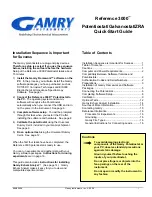
5
STEP 4:
Finally, connect the remaining cable end to the
signal conditioner.
6.0 Signal Conditioning
For optimum performance and flexibility, high sensitivity
DC accelerometers benefit from a good stable, low noise
dc power supply for excitation (Fig. 6). It should be
regulated and stable to within 0.1% or better. Noise and
ripple should be equally low, since noise will be
transmitted directly to the signal leads of the bridge.
However, an unregulated DC supply may be used due to
the high sensitivity DC accelerometer having its’ own on-
board voltage regulator. The signal should be connected
to a good instrumentation grade differential input
amplifier. The amplifier should have high input
impedance (>1 MΩ) and good common mode rejection.
The amplifier should also have adequate bandwidth to
accommodate the measurement application.
NOTE: Damage to the sensor elements resulting from the
application of incorrect power, or the use of an
unapproved power source, is NOT covered by warranty.
Figure 6.
Typical DC Accelerometer Signal Conditioning
System Schematic
Figure 7.
Typical High Sensitivity DC Accelerometer
System Schematic
In general, battery-powered devices offer versatility for
portable, low-noise measurements, whereas line-powered
units provide the capability for continuous monitoring.
Note; High sensitivity DC Accelerometers feature on-
board differential amplification.
7.0 OPERATING
NOTE: Always operate the accelerometer within the
limitations listed on the enclosed Specification Sheet.
Operating the device outside these parameters can cause
temporary or permanent damage to the sensor.
8.0 ACCELEROMETER CALIBRATION
Accelerometer calibration provides, with a definable
degree of accuracy, the necessary link between the
physical quantity being measured and the electrical signal
generated by the sensor. In addition, other useful
information concerning operational limits, physical
parameters, electrical characteristics, or environmental
influences may also be determined. Without this link,
analyzing data becomes a nearly impossible task.
Fortunately, most sensor manufacturers provide a
calibration record that documents the exact characteristics
of each sensor. (The type and amount of data varies
depending on the manufacturer, sensor type, contractual
regulations, and other special requirements).
Under normal conditions, high sensitivity DC sensors are
extremely stable, and their calibrated performance
characteristics do not change over time. However, the
sensor may be temporarily or permanently affected by harsh
environments influences or other unusual conditions that
may cause the sensor to experience dynamic phenomena
outside of its specified operating range.


































